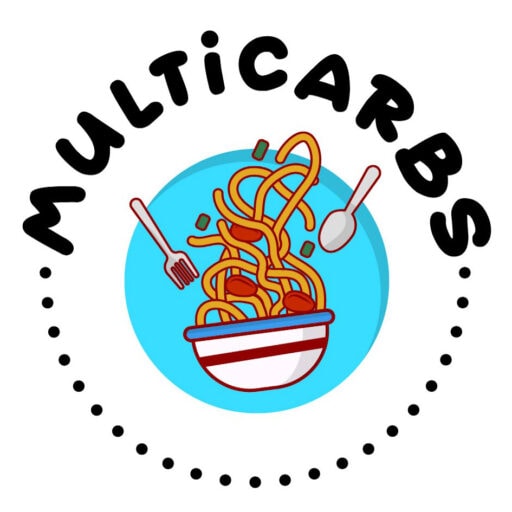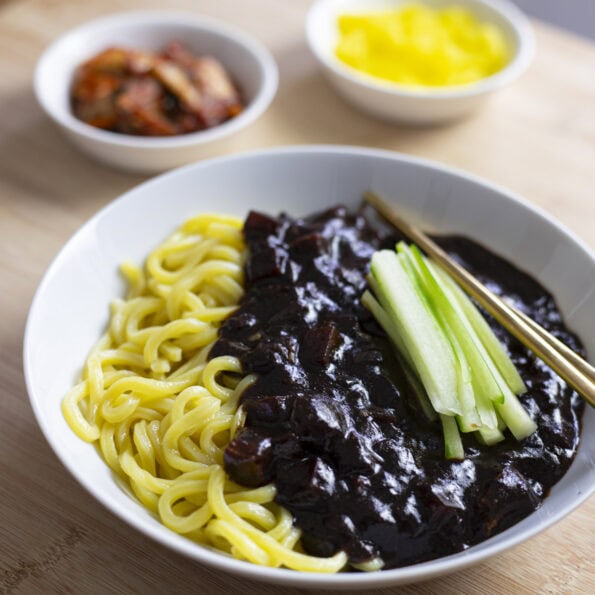
Korean noodles with black bean sauce (JJajangmyeon)

Korean noodles with black bean sauce (JJajangmyeon) - Recipe
Ingredients - Advice & where to find them
- Pork : I love to use pork belly here, ever the flavour booster but feel free to substitute with chicken thighs, which also has an interesting fat profile.
- You can definitely eat a vegetarian version of this Jjajangmyeon, as the main flavour is in the black bean paste ! I'd replace the meat with cubed and soaked (~15mn) dried shiitakes, around 10 of them. I'd also add 1 more tablespoon of oil to make up for the lack of added fat.
- Replace cabbage with zucchini in summer ! Both versions are authentic.
- Try to find Jjajangmyeon noodles ! I get them at the frozen section of my Korean store. They are bouncy and slippery, making it perfect for slurping the noodles. They get denser than spaghetti noodles, but less so then udon noodles. You can use udon noodles as a replacement, and it will still be delicious.
- You should also be able to find black bean paste and Korean radish (or daikon) at your Korean grocery store. If all else fails, order your bean paste online and replace the radish with turnips !
How to eat Korean noodles with black bean sauce (JJajangmyeon)
- You can eat the Jjajang sauce with noodles as instructed, but feel free to try the other version of this dish, which is called Jjajangbap (myeon meaning noodles, and bap meaning rice).
- The dish is usually served with two banchans : Kimchi and Danmuji (yellow pickled radish).
Slurpy, umami thick noodles, that feel like a hug in a bowl while not being too indulging. One of Koreans' favourites.
- 500 grams pork belly (cut into cu bes)
- 2,5 cups onion (~2 medium)
- 1,5 cup cabbage (replace with zucchini in summer)
- 1,5 cup potato
- 1,5 cup daikon
- 1/2 cup black bean paste (chunjang)
- 2 teaspoons sesame oil
- 4 tablespoons potato starch (or cornstarch)
- 6 jjajangmyeon noodle servings (~170g/serving)
- 1/2 cucumber (cut into matchsticks)
- 3 tablespoons vegetable oil
- 1 liter water
- 4 tablespoons cornstarch (or potato starch ideally)
- 1/2 cup water
- 1 tablespoon sugar
- Prepare your ingredients
Cut your potato, daikon, onion, and cabbage into small cubes.
Do the same with your pork belly.
- Cooking time !
Heat up a large wok to medium-high heat, with 1/3 of your neutral oil.
Cook your pork until golden-brown and slightly crispy, about 10 minutes.
Meanwhile, cut your cucumber into matchsticks and prep your slurry by mixing all the ingredients together.
When the pork is cooked, add radish & potato and stir fry for 1 minute.
Add onion, and cabbage/zucchini and keep stirring for about 3 minutes.
Push the ingredients to the sides and add your remaining oil in the empty center of the wok. Add your black bean paste and stir-fry for 1 to 2 minutes.
Mix everything together.
- Let it simmer
Add 4 cups of water to the wok. Let everything simmer for about 10 minutes.
Meanwhile, set a water pot on high heat for your noodles.
Taste the veggies to check they are fully cooked. If so, add your slurry little by little, stirring as you do so. Stir for 30 more seconds, or until thick and glossy.
Launch your noodles ; they usually take only 1 minute to cook.
Then plate it up ; noodles first, then top it the jjajang sauce, then with a handful of cucumber matchsticks.
Et voilà !! You're done !
Thank you for trying out this recipe ! Do not hesitate to leave some feedback. I hope it brightened your day.